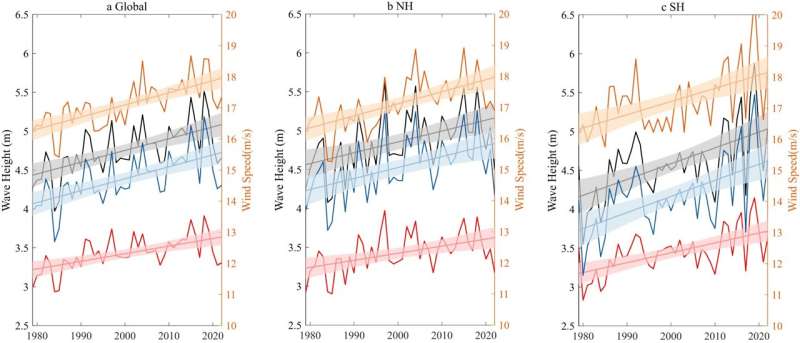This article has been reviewed according to Science X's editorial process and policies. Editors have highlighted the following attributes while ensuring the content's credibility:
fact-checked
peer-reviewed publication
trusted source
proofread
Hurricane waves hitting Americas grow 20% per decade: Study

The U.S., Mexico and countries in the Caribbean are being battered by hurricane-induced ocean waves that have grown in areal size by 80% over the past 40 years, a new study has found.
The first global trend study of its kind, led by Hohai University in China, investigated the long-term changes in both the height and surface area coverage of global tropical cyclone ocean surface waves since 1979. Published in Nature Communications, the study found the coverage area of ocean waves generated by tropical cyclones increased by nearly 20% (167,000 km2, about the size of Florida State) per decade in the North Atlantic Ocean.
Globally, the area of ocean waves increased by 6% per decade from 1979 to 2022. The maximum height of ocean waves caused by tropical cyclones grew by 3% per decade.
Dr. Xiangbo Feng, a University of Reading tropical storm expert who co-authored the study, said, "The rapid growth of tropical cyclone waves over recent decades is extremely worrying given their immense danger to communities, businesses and ecosystems. Our results show that the threat from their waves is escalating fast across the globe.
"Hurricanes whip up huge, devastating waves over that quickly swamp coastlines. Their long, rolling swells also travel hundreds of miles, flooding distant areas, so coastal towns and vessels urgently need to prepare better defenses—especially in the Americas—to avoid damage from these extreme waves."
Extreme ocean waves
Tropical cyclones, also known as hurricanes in the North Atlantic and East Pacific or known as typhoons in the West Pacific, are rapidly spinning storms that form over warm ocean waters in tropical regions. As tropical cyclones move across the ocean, their strong winds stir up large waves from the storm's center.
The highest tropical cyclone-induced ocean wave height ever recorded (defined as the mean height of the highest one-third of waves measured from trough to crest) was 24 m, caused by Typhoon Krosa in 2007 in the West Pacific.
In addition to wave heights and area coverage rising, the study also found that the total wave energy produced by tropical cyclones has increased by 9% per decade globally. The largest increase of 30% per decade was found in the East Pacific and North Atlantic.
These increases pose a greater danger to North American and Caribbean countries by the North Atlantic Ocean where the frequency of major hurricanes has been increasing in the past several decades. One previous hurricane to hit the U.S. and Caribbean was Katrina in August 2005, a tropical cyclone that killed at least 1,500 people. Huge waves and storm surges contributed to flooding and beach erosion, leading to injuries, deaths and around $300 billion worth of damage in affected states such as Florida, Louisiana and Mississippi.
Climate change impact
The researchers anticipate that ocean wave size (defined by the overall height and the footprint area) is likely to substantially increase in the future due to a combination of factors, including tropical cyclone intensity, size, and translation speed (how fast tropical cyclones move across the Earth's surface). The authors suggest more research is needed to understand the multiple effects of global warming on extreme wave height.
As tropical cyclone waves become higher and more frequent in this region, the new study emphasizes the need for proactive preparation in coastal regions vulnerable to tropical storms. Larger areas will endure damaging winds and high waves when tropical cyclones make landfall.
More information: Jian Shi et al, Global increase in tropical cyclone ocean surface waves, Nature Communications (2024). DOI: 10.1038/s41467-023-43532-4
Journal information: Nature Communications
Provided by University of Reading




















